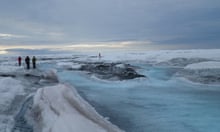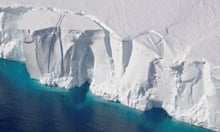Half the planet’s glaciers will have melted by 2100 even if humanity sticks to goals set out in the Paris climate agreement, according to research that finds the scale and impacts of glacial loss are greater than previously thought. At least half of that loss will happen in the next 30 years.
Researchers found 49% of glaciers would disappear under the most optimistic scenario of 1.5C of warming. However, if global heating continued under the current scenario of 2.7C of warming, losses would be more significant, with 68% of glaciers disappearing, according to the paper, published in Science. There would be almost no glaciers left in central Europe, western Canada and the US by the end of the next century if this happened.
This will significantly contribute to sea level rise, threaten the supply of water of up to 2 billion people, and increase the risk of natural hazards such as flooding. The study looked at all glacial land ice except for Greenland and Antarctic ice sheets.
If temperature increases are limited to 1.5C of warming, average sea levels would increase by 90mm (3.5in) from 2015 to 2100, but with 2.7C of warming, glacial melt would lead to around 115mm of sea level rise. These scenarios are up to 23% more than previous models had estimated.

Mountain glacier melt is believed to contribute to more than a third of sea level rise. A lot of this loss is unavoidable, but the magnitude of loss is directly related to temperature increases, so acting on the climate crisis is key. Researchers wrote in the paper: “The rapidly increasing glacier mass losses as global temperature increases beyond 1.5C stresses the urgency of establishing more ambitious climate pledges to preserve the glaciers in these mountainous regions.”
The team used two decades of satellite data to map the planet’s glaciers with greater precision than ever before. Previous models had relied on measurements of specific glaciers, and that information was then extrapolated, but now researchers could get data points on each of the planet’s 200,000 glaciers. For the first time, this gave them insight into how many would be lost under different climate change scenarios.
The study’s lead author, Dr David Rounce, a civil and environmental engineer from Carnegie Mellon University and the University of Alaska Fairbanks, said: “This is the first time we have isolated the number of glaciers that will be lost – before it was the total mass loss.” Most of the glaciers that will be lost are small, currently less than 1 sq km. Although they contribute less to the total volume, they are most vulnerable to change. This is why the total loss of mass is less – so, for example, under the 2.7C scenario 68% of glaciers will be lost but the relative mass is less – projected to be 32%.
Small glaciers are an important source of water and livelihood for millions of people. Rounce said: “When we think about the locations where most people see and visit glaciers, it’s really in locations where they’re accessible, like in central Europe, or in high mountain Asia. In these regions there are a lot of smaller glaciers. They’re really at the core of the societies and economies of those locations.”
Lower mountain ranges such as the Alps and the Pyrenees are among those worst affected. In the Alps, for example, by 2050, glaciers are expected to be on average 70% smaller, many of the smaller ones would have already disappeared, with snow tops replaced by bare rock in some locations, and with significant losses in biodiversity as a result. Alpine flowers could become extinct after glaciers disappear as more competitive species colonise terrain higher up the mountain. Proglacial environments are highly sensitive to global heating, and mountain species are subject to the “escalator to extinction”.
This is not the first research to project sea level rise from glacial melt, but the projections are more accurate than previous models. It follows research from 2021 that found the speed of glacial melt had doubled in the past two decades, contributing more to sea level rise than either the Greenland or Antarctic ice sheets.
Prof Antonio Ruiz de Elvira, from the University of Alcalá, who was not involved in the paper, said all existing evidence was consistent with the results. He said: “The study makes much of the earlier partial data more concrete.”
In emphasising the importance of glaciers, he said: “In California, the water needed to sustain agriculture comes from glaciers directly from the end of July. In Spain, the disappearance of the Sierra Nevada glaciers means an almost complete reduction in water availability there from that time onwards, and the same applies to the glaciers in the Pyrenees. In India and China, they depend crucially on the Himalayan glaciers.”
Find more age of extinction coverage here, and follow biodiversity reporters Phoebe Weston and Patrick Greenfield on Twitter for all the latest news and features








